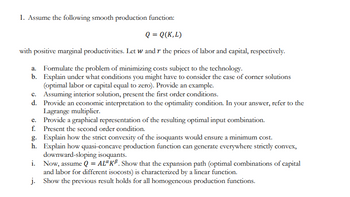1. Assume the following smooth production function: Q = Q(K,L) with positive marginal productivities. Let w and r the prices of labor and capital, respectively. a. Formulate the problem of minimizing costs subject to the technology. b. Explain under what conditions you might have to consider the case of corner solutions (optimal labor or capital equal to zero). Provide an example.
1. Assume the following smooth production function: Q = Q(K,L) with positive marginal productivities. Let w and r the prices of labor and capital, respectively. a. Formulate the problem of minimizing costs subject to the technology. b. Explain under what conditions you might have to consider the case of corner solutions (optimal labor or capital equal to zero). Provide an example.
Chapter1: Making Economics Decisions
Section: Chapter Questions
Problem 1QTC
Related questions
Question
Micro Question 1
Please help to solve this. Thank you

Transcribed Image Text:1. Assume the following smooth production function:
Q = Q(K,L)
with positive marginal productivities. Let w and r the prices of labor and capital, respectively.
a. Formulate the problem of minimizing costs subject to the technology.
b.
Explain under what conditions you might have to consider the case of corner solutions
(optimal labor or capital equal to zero). Provide an example.
c. Assuming interior solution, present the first order conditions.
d.
Provide an economic interpretation to the optimality condition. In your answer, refer to the
Lagrange multiplier.
e.
Provide a graphical representation of the resulting optimal input combination.
f. Present the second order condition.
g. Explain how the strict convexity of the isoquants would ensure a minimum cost.
h.
Explain how quasi-concave production function can generate everywhere strictly convex,
downward-sloping isoquants.
i. Now, assume Q = AL" KB. Show that the expansion path (optimal combinations of capital
and labor for different isocosts) is characterized by a linear function.
j.
Show the previous result holds for all homogeneous production functions.

Transcribed Image Text:Greek Letters:
0: Usually a "type" of some sort; private information.
6: (Normal, exponential) discount rate; one period from now is worth d as much as now.
T: Used for many things, for instance, profit or probabilities.
Geometric Series:
If you have a geometric series arx¹, where a is any constant and 0 < x < 1, then the
series converges to
'i=0
Expert Solution
This question has been solved!
Explore an expertly crafted, step-by-step solution for a thorough understanding of key concepts.
This is a popular solution!
Trending now
This is a popular solution!
Step by step
Solved in 3 steps

Follow-up Questions
Read through expert solutions to related follow-up questions below.
Follow-up Question
Please continue to solve from part d to part j. Thank you very much

Transcribed Image Text:1. Assume the following smooth production function:
Q = Q(K,L)
with positive marginal productivities. Let w and r the prices of labor and capital, respectively.
a. Formulate the problem of minimizing costs subject to the technology.
b.
Explain under what conditions you might have to consider the case of corner solutions
(optimal labor or capital equal to zero). Provide an example.
c. Assuming interior solution, present the first order conditions.
d.
Provide an economic interpretation to the optimality condition. In your answer, refer to the
Lagrange multiplier.
e.
Provide a graphical representation of the resulting optimal input combination.
f. Present the second order condition.
g. Explain how the strict convexity of the isoquants would ensure a minimum cost.
h.
Explain how quasi-concave production function can generate everywhere strictly convex,
downward-sloping isoquants.
i. Now, assume Q = AL" KB. Show that the expansion path (optimal combinations of capital
and labor for different isocosts) is characterized by a linear function.
j.
Show the previous result holds for all homogeneous production functions.
Solution
Knowledge Booster
Learn more about
Need a deep-dive on the concept behind this application? Look no further. Learn more about this topic, economics and related others by exploring similar questions and additional content below.Recommended textbooks for you


Principles of Economics (12th Edition)
Economics
ISBN:
9780134078779
Author:
Karl E. Case, Ray C. Fair, Sharon E. Oster
Publisher:
PEARSON

Engineering Economy (17th Edition)
Economics
ISBN:
9780134870069
Author:
William G. Sullivan, Elin M. Wicks, C. Patrick Koelling
Publisher:
PEARSON


Principles of Economics (12th Edition)
Economics
ISBN:
9780134078779
Author:
Karl E. Case, Ray C. Fair, Sharon E. Oster
Publisher:
PEARSON

Engineering Economy (17th Edition)
Economics
ISBN:
9780134870069
Author:
William G. Sullivan, Elin M. Wicks, C. Patrick Koelling
Publisher:
PEARSON

Principles of Economics (MindTap Course List)
Economics
ISBN:
9781305585126
Author:
N. Gregory Mankiw
Publisher:
Cengage Learning

Managerial Economics: A Problem Solving Approach
Economics
ISBN:
9781337106665
Author:
Luke M. Froeb, Brian T. McCann, Michael R. Ward, Mike Shor
Publisher:
Cengage Learning

Managerial Economics & Business Strategy (Mcgraw-…
Economics
ISBN:
9781259290619
Author:
Michael Baye, Jeff Prince
Publisher:
McGraw-Hill Education